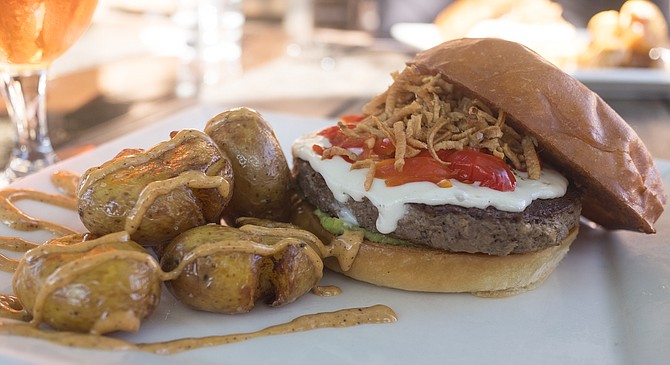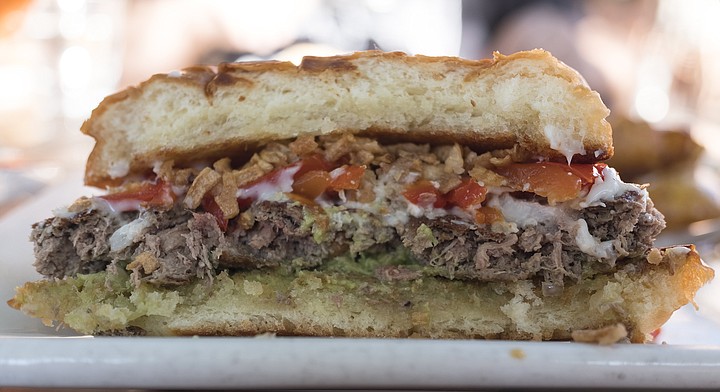 Facebook
Facebook
 X
X
 Instagram
Instagram
 TikTok
TikTok
 Youtube
Youtube

It was last February I first read an NPR story about the Impossible Burger — a meatless burger patty that "bleeds like the real thing." The sizzling, plant-based burger apparently debuted to rave reviews in select restaurants on the east coast, so, naturally, I've been eager to try it. But, like most trends that start in New York City, this one took about a year to reach San Diego.
Finally, in late December, it began to turn up at a small number of local restaurants: Jayne's Gastropub in North Park, and both the Escondido and Liberty Station locations of Stone Brewing World Bistro & Gardens.
I head over to Liberty Station to try it at Stone — a fitting choice considering, like beer, the secret ingredient in the Impossible Burger is a byproduct of yeast.

As the story goes, scientists at Impossible Foods — a Silicon Valley company founded by a Stanford biochemistry professor — identified the flavor compounds and proteins that give cooked beef its distinctive flavor and texture, then sought plant-based replacements for both.
The resulting burger patty is pressed together with wheat and potato proteins for chew, (flavorless) coconut oil for fat, and common thickening agents like xantham gum and konjac gum to gel it together. But what really makes the Impossible Burger unique is heme. That's the iron-rich compound found in hemoglobin that gives blood its red color, and gives cooked beef a meaty flavor that no well-meaning veggie burger has ever gotten right.
Impossible discovered that heme exists in soy bean roots, though in amounts too small to supply food production. Its clever workaround was to modify the gene of a species of yeast so that it converts sugars into heme. So whereas Stone uses yeast to produce the dank, citrusy IPAs it pairs with its burgers, Impossible Foods uses it to concoct a blood-red soy leghemoglobin.
Ah, science.
Knowing all this, I was cautiously optimistic approaching the Impossible Burger. I tried its key competitor, the Beyond Burger, last year. That pea-protein and bamboo cellulose patty uses beet juice to "bleed," and while I deemed it the best veggie burger I'd ever tried, it couldn't match beef's texture, nor quite its flavor. I figured this would be more of the same, and if nothing else would give astronauts another dining option up on that space station.
Safe to say the Impossible exceeded my expectations. Stone serves it with avocado, crispy sunchoke, Peruvian peppers and melted cheese on a brioche bun (cheese-free on a ciabatta if you want it vegan). But served with simple cheddar, onions, and pickles, my incredulity would have been the same
That faux beef patty looked remarkably similar to the sort of puckish, pre-formed burger patties you might find sold in bulk at Costco. It caramelized on the grill, and approximated the grayish-brown shade of any burger you'd find at a cafeteria or fast food joint. But it wasn't till I started breaking pieces of "beef" off the patty to nibble on that I was truly confounded. These little bits looked like ground beef. They had the texture of ground beef. And had a flavor I could only call "beefy." It's not exactly as juicy or robust as the real thing, but I wouldn't compare it to anything else. Bottom line, it tastes savory, a little salty, and pretty dang good.
Served with smashed potatoes, Stone charges $17 for its Impossible Burger, which is roughly in line with the rest of its menu. Jayne's charges $18.50. Real burgers rarely cost this much, and for now the real thing still tastes better. But that doesn't take away the accomplishment. This thing's a legit beef replacement, should you be looking for one, and an exciting moment of the present day catching up to science fiction.


It was last February I first read an NPR story about the Impossible Burger — a meatless burger patty that "bleeds like the real thing." The sizzling, plant-based burger apparently debuted to rave reviews in select restaurants on the east coast, so, naturally, I've been eager to try it. But, like most trends that start in New York City, this one took about a year to reach San Diego.
Finally, in late December, it began to turn up at a small number of local restaurants: Jayne's Gastropub in North Park, and both the Escondido and Liberty Station locations of Stone Brewing World Bistro & Gardens.
I head over to Liberty Station to try it at Stone — a fitting choice considering, like beer, the secret ingredient in the Impossible Burger is a byproduct of yeast.

As the story goes, scientists at Impossible Foods — a Silicon Valley company founded by a Stanford biochemistry professor — identified the flavor compounds and proteins that give cooked beef its distinctive flavor and texture, then sought plant-based replacements for both.
The resulting burger patty is pressed together with wheat and potato proteins for chew, (flavorless) coconut oil for fat, and common thickening agents like xantham gum and konjac gum to gel it together. But what really makes the Impossible Burger unique is heme. That's the iron-rich compound found in hemoglobin that gives blood its red color, and gives cooked beef a meaty flavor that no well-meaning veggie burger has ever gotten right.
Impossible discovered that heme exists in soy bean roots, though in amounts too small to supply food production. Its clever workaround was to modify the gene of a species of yeast so that it converts sugars into heme. So whereas Stone uses yeast to produce the dank, citrusy IPAs it pairs with its burgers, Impossible Foods uses it to concoct a blood-red soy leghemoglobin.
Ah, science.
Knowing all this, I was cautiously optimistic approaching the Impossible Burger. I tried its key competitor, the Beyond Burger, last year. That pea-protein and bamboo cellulose patty uses beet juice to "bleed," and while I deemed it the best veggie burger I'd ever tried, it couldn't match beef's texture, nor quite its flavor. I figured this would be more of the same, and if nothing else would give astronauts another dining option up on that space station.
Safe to say the Impossible exceeded my expectations. Stone serves it with avocado, crispy sunchoke, Peruvian peppers and melted cheese on a brioche bun (cheese-free on a ciabatta if you want it vegan). But served with simple cheddar, onions, and pickles, my incredulity would have been the same
That faux beef patty looked remarkably similar to the sort of puckish, pre-formed burger patties you might find sold in bulk at Costco. It caramelized on the grill, and approximated the grayish-brown shade of any burger you'd find at a cafeteria or fast food joint. But it wasn't till I started breaking pieces of "beef" off the patty to nibble on that I was truly confounded. These little bits looked like ground beef. They had the texture of ground beef. And had a flavor I could only call "beefy." It's not exactly as juicy or robust as the real thing, but I wouldn't compare it to anything else. Bottom line, it tastes savory, a little salty, and pretty dang good.
Served with smashed potatoes, Stone charges $17 for its Impossible Burger, which is roughly in line with the rest of its menu. Jayne's charges $18.50. Real burgers rarely cost this much, and for now the real thing still tastes better. But that doesn't take away the accomplishment. This thing's a legit beef replacement, should you be looking for one, and an exciting moment of the present day catching up to science fiction.
Comments